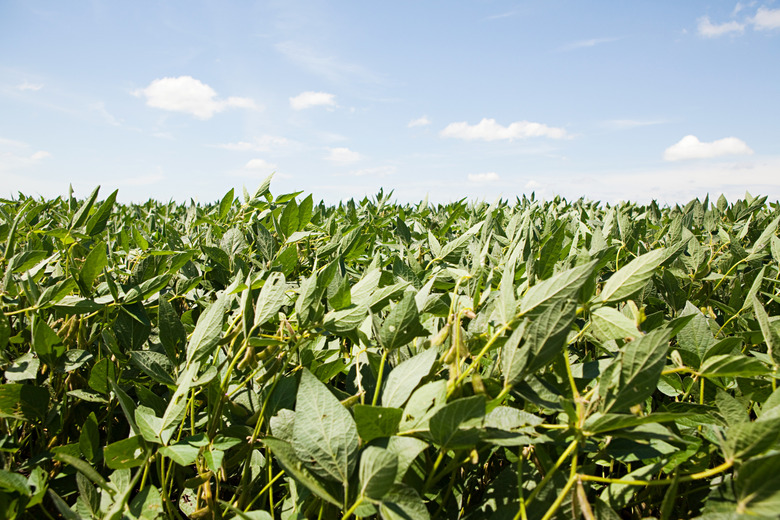Facts On Overpopulation And Deforestation In The Amazon Basin
Stretching over 4,000 miles from Peru to Brazil, the Amazon River drains the immense Amazon basin, which covers about 40 percent of South America. Containing the largest rainforest on Earth, the Amazon basin produces over 20 percent of the world's oxygen and holds about two-thirds of Earth's terrestrial water. Such richness is at risk, with almost 20 percent of the rainforest cut down during the last 40 years. Although overpopulation is a factor, land development does most damage.
Soybeans and Logging
Soybeans and Logging
Rainforest is invaded for valuable hardwoods, with loggers cutting roads into formerly inaccessible regions. As roads open up areas, squatters, miners and agriculturists follow, further exploiting the land. There are over 170,000 kilometers (105,000 miles) of unauthorized, mostly illegal roads that extend into the Amazon forest. International demand for soybeans for food and biodiesel resulted in extensive soybean plantations, with Brazilian harvests increasing from 1.5 million tons in 1970 to 57 million tons in 2006, destroying over 80 million hectares of land. Cutting down forests releases 86 times more carbon than the annual benefit from biofuel.
Cattle Farming
Cattle Farming
In 2003, cattle had increased to more than 70 to 80 million head from the count of 5 million head in the 1960s. About 15 percent of the Amazon rainforest was cut for cattle ranches. Areas most affected are Eastern Brazilian Amazon states of Maranhao and Para; Southern Brazilian states of Tocantins, Mato Grosso and Rondonia; and the Andean Amazon areas of Ecuador, Peru, Bolivia, Venezuela and Colombia. Cattle ranching increases about 5 to 8 percent each year, continuing to affect deforestation.
Mines and Minerals
Mines and Minerals
Amazonia contains a wealth of non-renewable natural resources such as:
- gold
- copper
- iron
- nickel
- bauxite
- tin
Governments encourage large-scale mining operations to encourage development. Operations cause not only deforestation, but pollution. Brazilian forests in Carajas Mineral Province are cut down at the rate of 6,100 square kilometers (2,355 square miles) a year for charcoal to fuel pig iron production. Mercury pollution affects 90 percent of fish caught in rivers near gold mining areas in Brazil.
Population Changes
Population Changes
With more food being produced, more people survive, leading to population increase. The river peoples that inhabit the Amazon have more children surviving disease and poor living conditions, and an influx of people from poor urban areas to riverbank communities further impacts the rainforest. Population shifts occur as land is degraded and no longer suitable for agriculture or for sustainable harvest of forest plants. Urban areas with electricity, schools and welfare programs gain population and many rural areas are losing people.
Impacts of Deforestation
Impacts of Deforestation
As plants no longer cover the soil, roots don't hold the soil in place and the leafy canopy doesn't protect the land from torrential rains. Soils wash away, silting up streams and rivers and removing soil necessary for agriculture. Biodiversity diminishes, since even fragmentation of lands by roads rather than clear-cutting affects wildlife populations negatively. Agricultural chemicals from plantations, improper disposal of human wastes from overpopulated areas and water contamination by mining wastes degrade water quality.
References
- Amazon Center for Environmental Education and Research: The Amazon Rainforest: The Amazon Basin: Amazing Facts and Figures
- World Information Transfer: Food For Thought — Soybean Endangers Brazil Amazon Rainforest
- United Nations Food and Agriculture Organization: Cattle Ranching in the Amazon Rainforest
- World Wildlife Fund: Amazon Mining
- Amazon Center for Environmental Education and Research: Peoples of the Rainforest: The Peoples of Amazonia
- University of Washington: Conservation: Amazon Exodus
Cite This Article
MLA
Csanyi, Carolyn. "Facts On Overpopulation And Deforestation In The Amazon Basin" sciencing.com, https://www.sciencing.com/overpopulation-deforestation-amazon-basin-23665/. 24 April 2017.
APA
Csanyi, Carolyn. (2017, April 24). Facts On Overpopulation And Deforestation In The Amazon Basin. sciencing.com. Retrieved from https://www.sciencing.com/overpopulation-deforestation-amazon-basin-23665/
Chicago
Csanyi, Carolyn. Facts On Overpopulation And Deforestation In The Amazon Basin last modified March 24, 2022. https://www.sciencing.com/overpopulation-deforestation-amazon-basin-23665/
